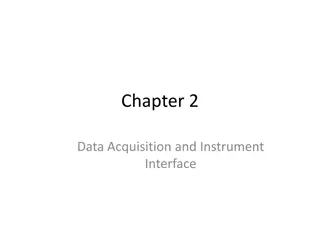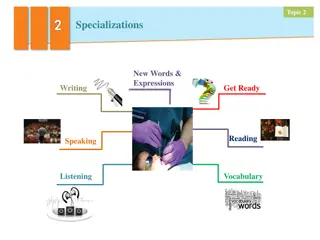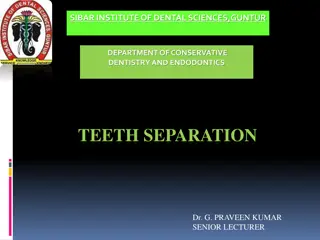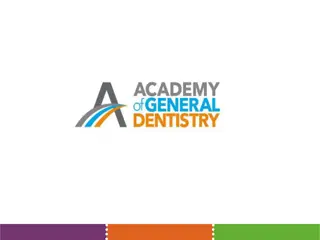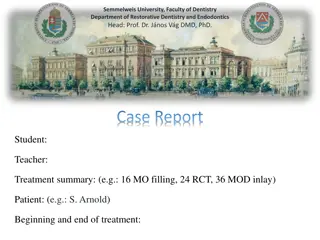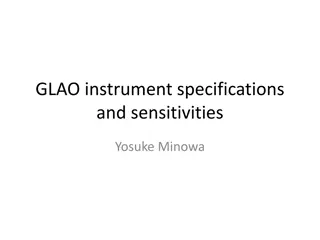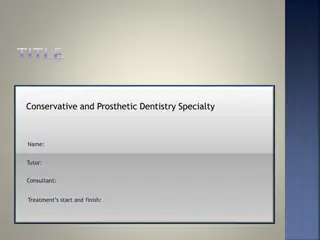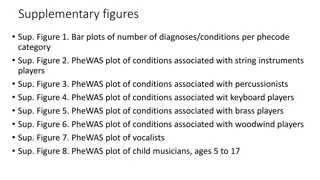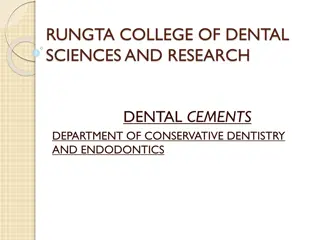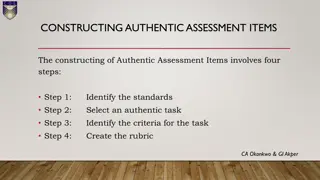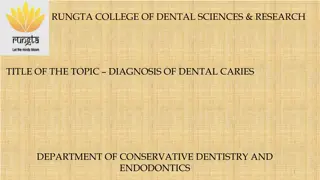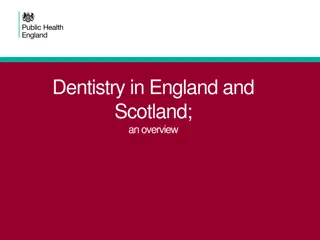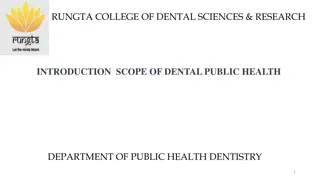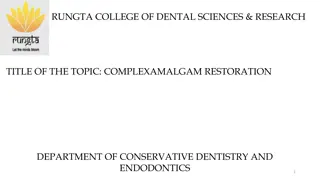Instrument Grasps in Conservative Dentistry and Endodontics
This presentation focuses on the essential grasps and techniques used in Conservative Dentistry and Endodontics. It covers specific learning objectives related to anatomy, diagnosis, and cognitive skills required in the field. Detailed explanations are provided on various instrument grasps and finger rests essential for optimal performance during dental procedures.
Download Presentation

Please find below an Image/Link to download the presentation.
The content on the website is provided AS IS for your information and personal use only. It may not be sold, licensed, or shared on other websites without obtaining consent from the author.If you encounter any issues during the download, it is possible that the publisher has removed the file from their server.
You are allowed to download the files provided on this website for personal or commercial use, subject to the condition that they are used lawfully. All files are the property of their respective owners.
The content on the website is provided AS IS for your information and personal use only. It may not be sold, licensed, or shared on other websites without obtaining consent from the author.
E N D
Presentation Transcript
1 RUNGTA COLLEGE OF DENTAL SCIENCES & RESEARCH TITLE OF THE TOPIC: DEPARTMENT OF CONSERVATIVE DENTISTRY AND ENDODONTICS
Specific learning Objectives At the end of this presentation the learner is expected to know ; 2 Core areas* Domain ** Category # ANATOMY OF PERIAPEX CEMENTUM PERIODOTAL LIGAMENT INGLES CLASSIFICATION ZONES OF FISH PATHWAY OF ENTRY OF MICROORGANISMS IN TOOTH DIAGNOSIS OF PERIAPICAL TISSUE ENDO PERIO LESSIONS COGNITIVE MUST KNOW PSYCHOMOTOR NICE TO KNOW AFFECTIVE DESIRE TO KNOW
CONTENTS INSTRUMENT GRASP MODIFIED PEN GRASP STANDARD PEN GRASP PALM AND THUMB GRASP FINGER REST CONVENTIONAL CROSS ARCH OPPOSITE ARCH FINGER ON FINGER
INSTRUMENT GRASP These are the manner of holding the instruments There are four grasps used with the hand instruments: Modified pen Inverted pen Palm and thumb Modified palm and thumb 1. 2. 3. 4.
FINGER REST : 1. CONVENTIONAL 2. CROSS ARCH 3. OPPOSITE ARCH 4. FINGER ON FINGER
PEN GRASP THE THUMB, INDEX FINGER & MIDDLE FINGER ARE USED TO HOLD INSTRUMENT AS PEN IS HELD
MODIFIED PEN GRASP THE MOST EFFECTIVE& STABLE GRASP THE PAD OF MIDDLE FINGER REST ON THE SHANK
PALM AND THUMB GRASP USEFUL FOR STABILISING INSTRUMENTS DURING SHARPENING & FOR MANIPULATING AIR & WATER SYRINGE NOT RECOMMENDED FOR PERIODONTAL INSTRUMENTATION
FINGER REST SERVES TO STABILIZE THE HAND & THE INSTRUMENT BY PROVIDING A FIRM FULCRUM AS A MOVEMENTS A GOOD FINGER REST PREVENT INJURY MAXIMAL CONTROL IS ACHIEVED BY USING MIDDLE FINGER MIDDLE FINGER IS KEPT BETWEEN THE INSTRUMENT SHANK AND FOURTH FINGER
FINGER REST INTRAORAL FINGER REST EXTRA ORAL FULCRUMS CONVENTIONAL 1. PALM UP CROSS ARCH 2. PALM DOWN OPPOSITE ARCH FINGER ON FINGER 1. 2. 3. 4.
INTRA ORAL FINGER REST ITS ON TOOTH SURFACE CLOSE TO THE WORKING AREA CONVENTIONAL : THE FINGER REST IS ESTLABLISHED ON TOOTH SURFACES IMMEDIATELY ADJACENT TO THE WORKING AREA
CROSS ARCH : THE FINGER REST IS ESTLABLISHED ON TOOTH SURFACES ON THE OTHER SIDE OF THE SAME ARCH
OPPOSITE ARCH : THE FINGER REST IS ESTLABLISHED ON TOOTH SURFACE ON THE OPPOSITE ARCH
FINGER ON FINGER : THE FINGER REST IS ESTLABLISHED ON THE INDEX FINGER OR THUMB OF THE NON OPERATING HAND
EXTRA ORAL FULCRUMS EFFECTIVE FOR POSTERIOR MAXILLARY TOOTH ALLOW OPTIMAL ACCESS & ANGULATION WHILE PROVIDING ADEQUATE STABILIZATION FINGERS IS PLACED ON THE PATEINTS FACE TO PROVIDE GREATEST DEGREE OF STABILITY
2 TYPES 1) PALM UP : THE PALM FULCRUM IS ESTLABLISHED BY RESTING THE BACKS OF THE MIDDLE FINGER & FOURTH FINGER ON THE SKIN OVERLYING THE LATERAL ASPECT OF MANDIBLE ON THE RIGHT SIDE OF THE FACE
PALM DOWN : THE PALM DOWN FULCRUM IS ESTLABLISHED BY RESTING THE FRONT SURFACES OF THE MIDDLE & FOURTH FINGER ON SKIN OVERLYING THE LATERAL ASPECT OF THE MANDIBLE ON THE LEFT SIDE OF FACE
INSTRUMENT ADAPTATION ADAPTATION : ADAPTATION REFERS TO THE MANNER IN WHICH THE WORKING END OF PERIODONATL INSTRUMENT IS PLACED AGAINST THE SURFACE OF TOOTH. OBJECTIVE IS TO MAKE THE WORKING END OF INSTRUMENT CONFORM THE CONTOUR OF THE TOOTH SURFACE
ANGULATION : IT REFERS TO THE ANGLE BETWEEN FACE OF A BLADED INSTRUMENT AND THE TOOTH SURFACE ALSO CALLED TOOTH- BLADE RELATIONSHIP DURING INSERTION ANGLE IS 0 DEGREE SCALING AND ROOT PALNING 45 TO 90 DEGREE
Take home message Dentistry a modified pen grasp is used. The middle finger is modified and the side of the finger placed on the shank of the instrument. The index finger is bent at the second joint and is positioned above the middle modified pen grasp finger on the same side of the handle.
Questions : Write a note on instrument grasp ? Write a note on finger rest ? Describe palm and thumb grasp. 1. 2. 3.
REFERENCES Jill Shiffer Nield-Gehrig, Fundamentals of periodontal instrumentation & advanced root instrumentation, 6th edition 2. Carranza's Clinical Periodontology, 9th edition 3. H. Dong, et al, The effects of finger rest positions on hand muscle load and pinch force in simulated dental hygiene work; Journal of Dental Education, Apr 2005 4. Gordon L. Pattison et al, Periodontal Instrumentation 5. Anna M. Pattison, Dimensions of Dental Hygiene, Oct 20046. Diane Millar, Reinforced Periodontal Instrumentation and Ergonomics for Dental Care Provider, Apr 2007



